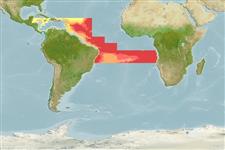Teleostei (teleosts) >
Stomiiformes (Lightfishes and dragonfishes) >
Phosichthyidae (Lightfishes)
Etymology: Ichthyococcus: Greek, ichthys = fish + Greek, kokkos = grain, berry (Ref. 45335).
Eponymy: Dr Max Fernand Leon Poll (1908–1991) was a Belgian ichthyologist, and ‘connoisseur of the fish fauna’. [...] (Ref. 128868), visit book page.
Environment: milieu / climate zone / depth range / distribution range
Ecology
Marine; bathypelagic; depth range 300 - 750 m (Ref. 3988), usually 550 - 750 m (Ref. 3988). Deep-water; 20°N - 16°S
Atlantic Ocean: St. Helena Island and western equatorial Atlantic.
Size / Weight / Age
Maturity: Lm ? range ? - ? cm
Max length : 9.1 cm SL male/unsexed; (Ref. 4470)
Mesopelagic species, adults mainly found at depths between 500-750 m (Ref. 3988).
Life cycle and mating behavior
Maturity | Reproduction | Spawning | Eggs | Fecundity | Larvae
Quéro, J.-C., J.C. Njock and M.M. de la Hoz, 1990. Photichthyidae. p. 343-348. In J.C. Quero, J.C. Hureau, C. Karrer, A. Post and L. Saldanha (eds.) Check-list of the fishes of the eastern tropical Atlantic (CLOFETA). JNICT, Lisbon; SEI, Paris; and UNESCO, Paris. Vol. 1. (Ref. 4470)
IUCN Red List Status (Ref. 130435: Version 2024-2)
Threat to humans
Harmless
Human uses
Tools
Special reports
Download XML
Internet sources
Estimates based on models
Preferred temperature (Ref.
123201): 12.4 - 15.1, mean 14.3 °C (based on 2075 cells).
Phylogenetic diversity index (Ref.
82804): PD
50 = 0.5078 [Uniqueness, from 0.5 = low to 2.0 = high].
Bayesian length-weight: a=0.00955 (0.00400 - 0.02282), b=3.06 (2.85 - 3.27), in cm total length, based on LWR estimates for this (Sub)family-body shape (Ref.
93245).
Trophic level (Ref.
69278): 3.4 ±0.5 se; based on size and trophs of closest relatives
Resilience (Ref.
120179): High, minimum population doubling time less than 15 months (Preliminary K or Fecundity.).
Fishing Vulnerability (Ref.
59153): Low vulnerability (10 of 100).
